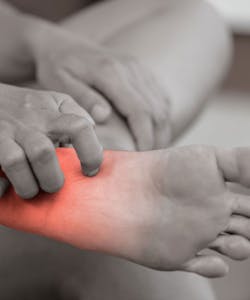
What is Peripheral Neuropathy?
Peripheral refers to nerves other than the spinal nerves and brain. Neuropathy literally translates as "nerve disease." Peripheral Neuropathy (PN), therefore, designates dysfunction or disease of peripheral sensory, motor, or autonomic nerves.
Causes of Peripheral Neuropathy
There are many causes of peripheral neuropathy - the largest being idiopathic, or undetermined. The next largest cause is diabetic peripheral neuropathy (DPN). Additional causes/associations include genetics, toxins, chemotherapy drugs, cancer, nutritional deficiencies, herpes zoster (shingles), HIV, and others.
Diabetic Peripheral Neuropathy (DPN)
DPN develops as a result of the effects of hyperglycemia (excess glucose or sugar in blood). It is the most common complication of diabetes, occurring in 1 out of every 5 diabetics. A potentially serious condition, DPN results in 1/2 to 3/4 of all non-trauma related amputations.
The consequences of elevated glucose include:
- Damages micro vessels which reduces blood flow and oxygen to nerves and cells.
- Reduced blood flow and oxygen (ischemia/hypoxia) damages nerves throughout the body:
- Starting at the distant nerve sites - peripheral neuropathy of feet and hands.
- Nerves of blood vessels, further reducing blood flow in a vicious cycle.
- Reduced blood flow damages certain organs including eyes and kidneys.
- Damages intracellular proteins (glycosylation) leading to peripheral neuropathy.
- Possibility that hyperglycemia is associated with overuse of polyol pathway, producing damaging cascade of effects, one of which is decreased levels of nitric oxide (an important vasodilator).
Symptoms
Any of the peripheral nerves can be affected by PN/DPN. There are pain sensing fibers, movement activating motor neurons, and autonomic nerves. These can be affected individually or in any combination (such as sensorimotor where both sensation and movement are involved). When these nerves become damaged for any of the above reasons, symptoms occur. Some of the many symptoms may include:
- Numbness, tingling, or sharp stabbing sensations in the extremities (peripheral neuropathies).
- Burning sensations in the extremities, especially in the evening/night (peripheral neuropathies).
- Muscle weakness or small twitching/spasms (fasciculation).
- Facial/mouth/eye drooping; swallowing, speech, and vision impairments of cranial nerve neuropathies.
- Cardiac, urinary and gastrointestinal autonomic system neuropathies.
Treatment
In general, there have been few options available for treating the actual underlying causes of neuropathy.
- The primary treatment of diabetic peripheral neuropathy focuses on tight control of blood glucose. Early, strict control may help limit or reverse initial developing stages of diabetic neuropathy. Poor control, long history of diabetes, increasing age, history of smoking, hypertension, hyperlipidemia, and obesity all increase the risk of developing or significantly worsening diabetic neuropathy.
- Otherwise, pharmaceuticals are used mostly for symptoms rather than reversal of neuropathy. Many drug-based therapies either have limited effectiveness or have secondary side effects which may reduce or prevent their use. Generally, available medications are used in an attempt to:
- Improve Circulation Flow (vasodilators)
- Control Nerve Pain
- Analgesics
- Ticyclic Antidepressants (TCAs)
- Serotonin Reuptake Inhibitors (SSRIs)
- Antiepileptic Drugs (AEDs)
- Some treatment approaches have not been studied in clinical trials, but have been utilized to achieve a decrease in chronic neuropathy pain.
- Interferential Stimulation
- Acupuncture
- Massage
- Prescribed Exercise
- Meditation/Cognitive Therapy
Now, an additional therapy modality is available for patients experiencing neuropathic symptoms. Clinical studies have been conducted on Monochromatic Infra-Red photo Energy (MIRE). Anodyne Therapy’s MIRE device has been cleared by the FDA for use in increasing local blood circulation and reducing pain. Just like other physical medicine modalities though, Anodyne Therapy is not cleared for (nor marketed for) specific conditions or diagnoses. However, 15 studies involving over 5000 patients have been published in peer-reviewed journals documenting efficacy of various uses, including neuropathic symptoms.
Of particular importance in neuropathy (both diabetic and non-diabetic):
- Circulation is impaired.
- Sensations of constant or stabbing pain, tingling, burning, or stinging occur frequently to relentlessly.
Anodyne Therapy increases free nitric oxide which has two crucial effects:
- As the body's most powerful vasodilator, it increases blood flow, oxygen, nutrients to tissues.
- Relieves pain, muscle spasm and stiffness.
Anodyne Therapy, therefore, may help reverse some of the underlying dysfunction involved, as well as providing symptom relief without adverse side effects. Anodyne Therapy treatments are typically provided along with personalized physical or occupational therapy based on identified needs, which may include gait and balance therapy, exercises for flexibility, strengthening and endurance, manual therapy, and others.
For more information on Anodyne Therapy, click here.